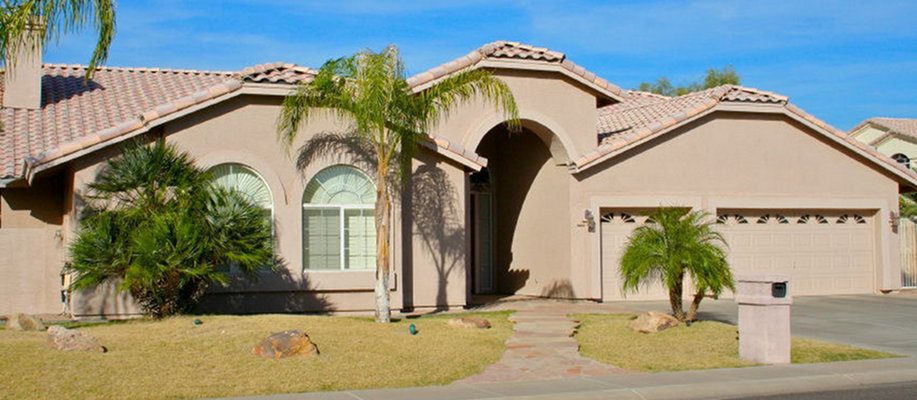My Blog
Archive for the ‘Housing Analysis’ Category
Building Permits Rising Nationwide; Housing Starts To Follow
 Single-Family Housing Starts fell for the second consecutive month, dropping to a seasonally-adjusted, annualized 417,000 units in August 2011.
Single-Family Housing Starts fell for the second consecutive month, dropping to a seasonally-adjusted, annualized 417,000 units in August 2011.
A “Housing Start” is defined as a home on which ground has broken.
We shouldn’t put too much faith in the findings, however. Although housing starts were lower last month, as noted by the Census Bureau, the margin of error in the August Housing Starts report exceeded the actual result.
From the official report:
- August’s Published Results : -1.4% from July
- August’s Margin of Error : ±10.3% from July
Therefore, August’s Housing Starts may have actually increased by up to +8.9% from July, or it may have dropped as much as -11.7%. We won’t know for sure until several months from now, after the Census Bureau has gathered more housing data.
One thing is certain, though — the long-term trend in Housing Starts is “flat”. There has been little change in new home construction since last summer.
The same can’t be said for Building Permits.
Considered a pre-cursor to Housing Starts, Single Family Building Permits climbed 2.5 percent with a minuscule Margin of Error of ±0.9 percent.
As is common in real estate, results varied by region:
- Northeast : +3.3 percent from July
- Midwest : +6.3 percent from July
- South : -1.3 percent from July
- West : +11.3 percent from July
When permits are issued, 86 percent of them begin break ground within 60 days. Therefore, expect Housing Starts and new home inventory to rebound in the months ahead.
For now, housing remains steady. And, with mortgage rates at all-time lows, homebuyer purchasing power in an around Scottsdale is higher than it’s been in history. If you’re in the process of shopping for a home, talk with your lender to plan your mortgage budget.
Mark Taylor | Arizona Home Loans | Blarming | Will You Listen to Me | Arizona Short Sales | Arizona Foreclosures | Arizona FHA Loans | Arizona USDA Loans | Real Estate Websites | Arizona HUD Homes | Ariona VA Loans | Fix My Broken Credit | Arizona Mortgage | Arizona Short Sale | Power Ranch Bank Owned Homes
Homebuilder Confidence Stays Flat

Homebuilders are feeling worse about the market for new homes nationwide.
With construction credit tight and competition from foreclosures increasing, the National Association of Homebuilder’s Housing Market Index slipped 1 point in September, falling to levels just below the index’s 12-month average.
The HMI measures homebuilder confidence nationwide. It’s the result of 3 separate homebuilder surveys, each designed to measure a specific facet of the homebuilder’s business.
- How are market conditions for the sale of new homes today?
- How are market conditions for the sale of new homes in 6 months?
- How is prospective buyer foot traffic?
Each component survey showed a drop-off from August. Responses fell 1 point, 2 points, and 2 points, respectively. Together, September’s composite reading was 14 out of a possible 100 points. Readings over 50 are considered favorable.
The HMI not been above 50 since April 2006.
With homebuilder confidence low — and stagnant — buyers of new homes Mesa in should remain alert for “deals”. Builders are more likely to offer free upgrades and other concessions to incoming buyers. The availability of such deals may increase as the seasons change and as the year comes to a close.
Low mortgage rates are making new homes attractive, too. Last week, 30-year fixed rate mortgage rates fell to their lowest levels of all-time. As compared to just 8 weeks ago, 30-year fixed rate mortgage payments are lower by 5 percent at all loan sizes, down $27 per month per $100,000 borrowed.
Mark Taylor | Arizona Home Loans | Blarming | Will You Listen to Me | Arizona Short Sales | Arizona Foreclosures | Arizona FHA Loans | Arizona USDA Loans | Real Estate Websites | Arizona HUD Homes | Ariona VA Loans | Fix My Broken Credit | Arizona Mortgage | Arizona Short Sale | Power Ranch Bank Owned Homes
Annual Foreclosure Filings Down For 11th Straight Month

On an annual basis, foreclosure filings fell last month. As compared to August 2010, last month’s foreclosure filings dropped 33 percent. “Foreclosure filing” is a catch-all term, comprising default notices; scheduled auctions; and bank repossessions.
The study was published by foreclosure-tracking firm RealtyTrac and this month’s report reveals a slowing rate of foreclosure within each of the Top 10 most foreclosure-heavy states.
All news is not good, however.
On a monthly basis, foreclosure filings spiked, led by a surge in default notices. Default notices made their biggest one-month jump since August 2007 on the way to a 9-month high last month. Default notices are the first step in the foreclosure process so this jump may foreshadow a large number of bank repossessions as foreclosures “make their way through the process“.
It’s also noteworthy that just 6 states housed half of the nation’s bank repossessions last month.
- California : 18 percent of bank repossessions
- Florida : 8 percent of bank repossessions
- Georgia : 7 percent of bank repossessions
- Michigan : 6 percent of bank repossessions
- Texas : 6 percent of bank repossessions
- Arizona : 6 percent of bank repossessions
As a home buyer in Mesa , foreclosures can save you money. The National Association of REALTORS® reports that distressed homes sell with typical discounts of 20 percent versus comparable, non-distressed homes. However, buying a home from a bank is a different process from buying a home from a “person”. Contract negotiations are different and it can take months to finally close on a foreclosed home.
If you’re buying a foreclosed, therefore, enlist the help of a professional real estate agent. Real estate agents can help you navigate the sometimes-complicated world of foreclosures, and help you come out ahead.
Mark Taylor | Arizona Home Loans | Blarming | Will You Listen to Me | Arizona Short Sales | Arizona Foreclosures | Arizona FHA Loans | Arizona USDA Loans | Real Estate Websites | Arizona HUD Homes | Ariona VA Loans | Fix My Broken Credit | Arizona Mortgage | Arizona Short Sale | Power Ranch Bank Owned Homes
Home Affordability Still Tops Nationwide
 Home affordability slipped slightly last quarter, dragged down by rising mortgage rates and recovering home prices in Arizona and nationwide.
Home affordability slipped slightly last quarter, dragged down by rising mortgage rates and recovering home prices in Arizona and nationwide.
The National Association of Home Builders reports a Q2 2011 Home Opportunity Index reading of 72.6. This means that nearly 3 of 4 homes sold last quarter were affordable to households earning the national median income of $64,200.
Q2 2011 marks the 10th straight quarter — dating back to 2009 — in which the index surpassed 70.
Prior to 2009, the index had never crossed 70 even one time.
However, we must remember that the Home Affordability Index is a national survey. From region-to-region, and town-to-town, home affordability varied.
In the Midwest, for example, affordability was highest. 14 of the 15 most affordable markets nationwide were spread throughout Ohio, Michigan, Illinois and Indiana. Only Syracuse (#9) cracked the list from other regions.
The top 5 most affordable cities in Q2 2011 were:
- Kokomo, IN (95.8%)
- Wheeling, WV (94.7%)
- Lansing, MI; East Lansing, MI (94.4%)
- Bay City, MI (94.3%)
- Youngstown, OH; Warren, OH; Boardman, OH (93.7%)
By contrast, the Northeast Region and Southern California ranked as the least affordable markets. Led by the New York-White Plains, NY-Wayne, NJ area, 7 of the 10 least affordable areas were in New York, New Jersey, and California. For the 13th consecutive quarter the New York metro area was ranked “Least Affordable”.
Just 25.2 percent of homes were affordable to households earning the area median income there.
The rankings for all 225 metro areas are available for download on the NAHB website.
Mark Taylor | Arizona Home Loans | Blarming | Will You Listen to Me | Arizona Short Sales | Arizona Foreclosures | Arizona FHA Loans | Arizona USDA Loans | Real Estate Websites | Arizona HUD Homes | Ariona VA Loans | Fix My Broken Credit | Arizona Mortgage | Arizona Short Sale | Power Ranch Bank Owned Homes
Home Values Rose In June 2011

Has housing turned the corner for good?
The June 2011 Case-Shiller Index reading posted strong numbers across the board, with each of the index’s 20 tracked markets showing home price improvement from May.
Some markets — Chicago and Minneapolis — rose as much as 3.2 percent.
The rise in values is nothing about which to get overly excited, however. The Case-Shiller Index is just re-reporting what multiple data sets have already shown about the summer housing market; that it was stronger than the spring market, and that a recovery is underway, but occurring locally, at different rates.
For example, the June 2011 Case-Shiller Index shows the following :
- Denver, Dallas, Washington D.C., and the “California Cities” bottomed in 2009. Each has shown steady improvement since.
- None of the Case-Shiller cities showed negative growth between May and June 2011.
- 12 of Case-Shiller’s tracked cities have improved over 3 consecutive months.
In isolation, these statistics appear promising, but it’s important to remember that the Case-Shiller Index is a backward-looking data set, focusing on just a portion of the national housing economy.
As an illustration, the Case-Shiller Index’s “national report” only includes data from 20 cities nationwide. They’re not the 20 biggest cities, either. Smaller metropolitan areas such as Minneapolis (#48) and Tampa (#51) are included.
Larger ones including Houston (#4), Philadelphia (#5) and San Jose (#10) are not.
In addition, the Case-Shiller index fails to track sales of condominiums, multi-unit homes and new construction. In some markets, including Chicago, these excluded home type can represent a large share of the overall market.
The Case-Shiller Index is a fine data set for policy makers and economists. It describes the broader housing market and shows long-term trends. For the individual home buyer in Scottsdale , however, it’s much less useful. More than “broad data”, you want focused data that’s current and relevant.
The best place for data like that is a local real estate agent.
Mark Taylor | Arizona Home Loans | Blarming | Will You Listen to Me | Arizona Short Sales | Arizona Foreclosures | Arizona FHA Loans | Arizona USDA Loans | Real Estate Websites | Arizona HUD Homes | Ariona VA Loans | Fix My Broken Credit | Arizona Mortgage | Arizona Short Sale | Power Ranch Bank Owned Homes
Pending Home Sales Slip In July; Creates Buyer Opportunity
 After 3 straight months of gains, the Pending Home Sales Index slipped 1 percent in July. The monthly report is published by the National Association of REALTORS® and measures the number of home under contract to sell nationwide.
After 3 straight months of gains, the Pending Home Sales Index slipped 1 percent in July. The monthly report is published by the National Association of REALTORS® and measures the number of home under contract to sell nationwide.
The Pending Home Sales Index is closely watched by Wall Street and analysts because it’s a forward-looking housing market indicator. Unlike most housing market data, though, Pending Home Sales forecasts a future housing market event. In this case, the Existing Home Sales report.
In its methodology, the Pending Home Sales Index states that 80% of homes under contract close within 2 months, with most of the remaining home going to closing within Months 3 and 4.
We would expect home sales data to taper into the fall buying season, but this year, they may taper more than normal. This is because, in a separate report, the National Association of REALTORS® said that contract cancellation rates are running high.
As compared to a 4 percent contract cancellation rate in May 2011, June and July both registered 16 percent. This means that fewer homes tallied as part of July’s Pending Home Sales Index will show up as “closed sales” this fall.
Contracts can be canceled for any number of reasons including more stringent mortgage guidelines, appraisals falling short of the purchase price, and changing mortgage loan limits.
For home buyers in Mesa , the Pending Home Sales Index may represent an opportunity. Not only are fewer homes going under contract nationwide, but with cancellation rates spiking, sellers may be more willing to “make a deal”.
Note, though, like all real estate, the pace at which homes go under contract is a “local” statistic; you can’t assume national data applies to all markets equally. Your home market, for example, may out-perform — or under-perform — the national average.
For a closer look at what’s happening on your street including the speed at which homes are selling, talk to a local real estate agent.
Mark Taylor | Arizona Home Loans | Blarming | Will You Listen to Me | Arizona Short Sales | Arizona Foreclosures | Arizona FHA Loans | Arizona USDA Loans | Real Estate Websites | Arizona HUD Homes | Ariona VA Loans | Fix My Broken Credit | Arizona Mortgage | Arizona Short Sale | Power Ranch Bank Owned Homes
New Home Supplies Remain Flat; Builders Not Over-Extending

Sales of newly-built homes slipped in July, falling 1 percent as compared to June. Home buyers closed on a seasonally-adjusted, annualized 298,000 units, the lowest reading since February.
The supply of new homes, however, remained flat.
July’s 6.6 months of supply equaled June’s tally and remains near the multi-year low of 6.5 months set in May of this year. The figures suggest a new home market that’s finding its balance.
Builders are building to meet demand, and not much more.
The New Home Sales report may have read differently if not for the Northeast Region which doubled its sales units in July. The gains buoyed the broader data, re-affirming the importance of looking past national data and focusing on what’s local; the national market is not reflective of any given town
Broken down by region, July New Home Sales fared as follows:
- Northeast Region : +100.0% from June 2011
- Midwest Region : +2.4% from June 2011
- South Region : -7.4% from June 2011
- West Region : -5.9% from June 2011
However, as with most months, it’s important that we recognize the New Home Sales data’s margin of error.
Although New Home Sales showed a 1 percent drop in July, the reported margin of error was ±12.9%. This means that the actual reading could have been as high as +11.9 percent, or as low as -13.9 percent. Because the range includes both positive and negative values, the Census Bureau assigned its July data “zero confidence”.
New Home Sales appear to be stable, despite falling sales figures. Supplies remain flat and builder confidence does, too. The good news for buyers in Phoenix , then, is that lower mortgage rates are making homes more affordable.
Mortgage rates are currently at 50-year lows.
Mark Taylor | Arizona Home Loans | Blarming | Will You Listen to Me | Arizona Short Sales | Arizona Foreclosures | Arizona FHA Loans | Arizona USDA Loans | Real Estate Websites | Arizona HUD Homes | Ariona VA Loans | Fix My Broken Credit | Arizona Mortgage | Arizona Short Sale | Power Ranch Bank Owned Homes
Existing Home Sales Slip In July
 Home resales slipped in July.
Home resales slipped in July.
According to the National Association of REALTORS®, Existing Home Sales nationwide fell to 4.67 million units on a seasonally-adjusted annualized basis last month. It’s the fourth straight month below the 5 million mark, and the report’s lowest reading since November 2010.
An “existing home” is a home that’s been previously occupied or owned.
In addition, the Existing Home Sales report showed home supplies rising nationwide. At the current pace of sales, in other words, the complete, national “For Sale” inventory would be exhausted in 9.4 months. This, too, is the worst reading since November 2010.
On a units basis, however, the number of homes for sale actually fell in July. As compared to June, home resale inventory dropped 65,000 units to 3.65 million.
From these figures, we can infer that, despite low mortgage rates and lagging home values, buyer activity is slowing in AZ and nationwide. This may be seasonal, or it may be a long-term trend.
Either way, there’s opportunity for today’s home buyers.
With mortgage rates at all-time lows, home affordability is peaking. More households can afford housing payments than during any time in history and with the fall season approaching, buyers in Phoenix may find contracts negotiations to be more “friendly”.
This can mean lower sale prices and larger concessions from sellers — the hallmark of a Buyer’s Market.
It’s a good time to look at your options. Talk to your real estate agent and see what’s out there for you. Low home prices may persist, but low mortgage rates likely won’t.
Mark Taylor | Arizona Home Loans | Blarming | Will You Listen to Me | Arizona Short Sales | Arizona Foreclosures | Arizona FHA Loans | Arizona USDA Loans | Real Estate Websites | Arizona HUD Homes | Ariona VA Loans | Fix My Broken Credit | Arizona Mortgage | Arizona Short Sale | Power Ranch Bank Owned Homes
Housing Starts Tick Lower; Building Permits Tick Higher
 Single-Family Housing Starts fell to a seasonally-adjusted, annualized 425,000 units in July, according to the Census Bureau.
Single-Family Housing Starts fell to a seasonally-adjusted, annualized 425,000 units in July, according to the Census Bureau.
A “Housing Start” is defined as a home on which construction has started and ground has broken.
Furthermore, Single-Family Housing Starts were revised lower for both May and June of this year, by 6,000 units and 2,000 units, respectively.
The data may be worthless, however.
Like in most months, the government’s official report states that the Housing Starts numbers have a margin of error exceeding their actual measurement. Mathematically, this renders the data statistically irrelevant.
- July Published Results : +4.9%
- July Margin of Error : ±8.9%
In other words, July Housing Starts made have increased by as much as 13.8%, or they may have dropped up to 4.0%. We won’t know for certain until several months from now, when the Census Bureau gathers more data.
Regardless, the trend in Housing Starts has been flat since last summer. July’s reading is in-line with the 12-month average and, not surprisingly, New Home Sales have been mostly flat over the same time span.
Also included in the Housing Starts report is the Building Permits tally. As compared to June, permits were higher by a half-percent nationwide, with varying results by region.
- Northeast : +2.9 percent from June
- Midwest : +0.0 percent from June
- South : -1.4 percent from June
- West : +4.9 percent from June
When permits are issued, 86 percent of them start construction within 60 days. This means that new home sales and housing stock should follow the Building Permits trend, but on a 2-month delay.
Expect improvement into the fall season.
Mark Taylor | Arizona Home Loans | Blarming | Will You Listen to Me | Arizona Short Sales | Arizona Foreclosures | Arizona FHA Loans | Arizona USDA Loans | Real Estate Websites | Arizona HUD Homes | Ariona VA Loans | Fix My Broken Credit | Arizona Mortgage | Arizona Short Sale | Power Ranch Bank Owned Homes
Homebuilders Expect A Soft Winter Housing Market

Two months after posting their worst confidence reading of 2011, home builders say they foresee no improvement in the immediate- or medium-term market for new homes nationwide.
In August, for the second straight month, the Housing Market Index read 15.
The HMI is a monthly housing survey, published by the National Association of Homebuilders. It’s scored on a scale of 1-100 with readings over 50 suggesting favorable home builder conditions. Readings under 50 suggest unfavorable conditions.
The Housing Market Index has been below the 50-point benchmark since 2006.
To calculate the HMI, home builders are asked 3 separate questions, each addressing the different element of the new home sales business.
- How are today’s market conditions for the sale of new homes?
- How do you expect market conditions to be 6 months from now?
- How are the current foot traffic of prospective buyers?
Based on the August answers to these questions, builders are witnessing an improvement with the current market, partially fueled by low mortgage rates, but expect momentum to fade into early-2012.
As a home buyer in Scottsdale , this may bode well for you. If you can wait to buy a home, you may find builders more willing to concede on price or upgrades.
The other side of that conversation, though, is that while you may save money on the home, you may lose it in your monthly payments. Rising mortgage rates can quickly zap your savings — adding tens of thousands in interest costs to your budget long-term.
For now, home prices remain low and mortgage rates do, too. Home affordability is at an all-time high. Take advantage of what the market gives you.
Mark Taylor | Arizona Home Loans | Blarming | Will You Listen to Me | Arizona Short Sales | Arizona Foreclosures | Arizona FHA Loans | Arizona USDA Loans | Real Estate Websites | Arizona HUD Homes | Ariona VA Loans | Fix My Broken Credit | Arizona Mortgage | Arizona Short Sale | Power Ranch Bank Owned Homes









































